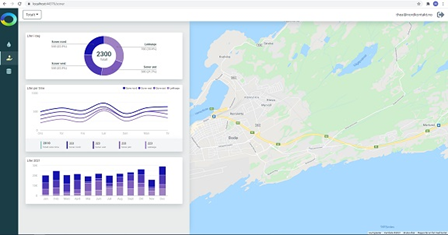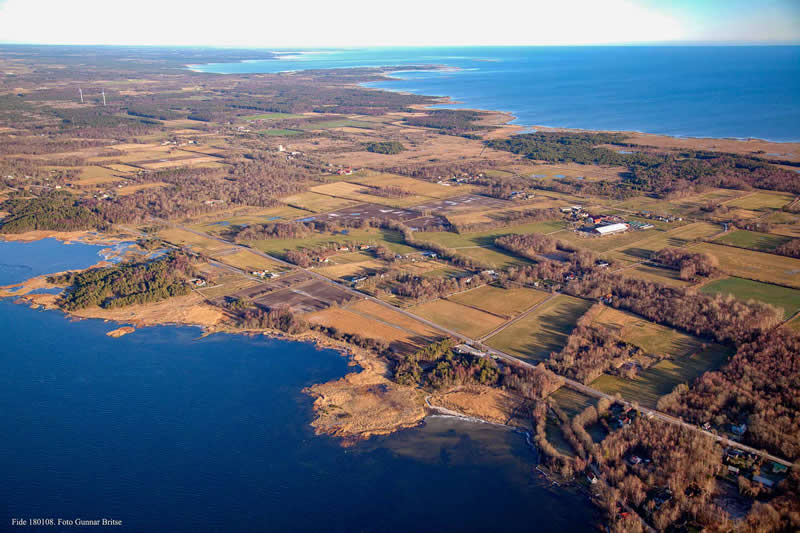Description
In recent years, Gotland has on several occasions suffered from severe water shortages. The southern part, Storsudret, is especially hard affected due to very thin soil layers that have difficulty retaining the groundwater. The area is therefore dependent on "imported water" from a new desalination plant at a distance of 25 km. In parallel with the construction of the desalination plant, Region Gotland has seen a need to contribute to the development of complementary systems for the water supply of the future. For this purpose, Region Gotland, together with IVL Swedish Environmental Institute, has begun the construction of a so-called test bed for sustainable water supply. This testbed is focusing on the development of future technologies for energy-efficient and sustainable water production.
The heart of the test bed is a large number of sensors that measure precipitation, flows in ditches and groundwater levels in real time and online. In addition to providing the researchers with data, the sensors' data will be used for active control of the water balance at Storsudret. This is achieved by using the ditches that today remove water from land and into the sea to instead, through active regulation, function as a collector of water for storage for the summer.
During the dry summer period, purification techniques for reusing wastewater are developed by purifying this to drinking water quality. In order to be able to store larger volumes of water, membrane technology is being developed to be able to purify water from shallow lakes in a robust way. To avoid long pipelines, technology is being developed to find groundwater reservoirs close to designated new construction areas.
To give and get ideas for how the water supply should be managed in the best way, the local engagement is very important. This is mainly done though close collaboration with the local NGO Forum Östersjön. Together with Forum Östersjön Testbed Storsudret arrange meetings, “Coffee-dialogs”, open for all inhabitants at Storsudret but also meetings in smaller groups with landowners and other stakeholders.
Technology performance and best practices
Decentralised membrane treatment
Without the NextGen solution for sewage treatment, no water would be reused. How much water could be recovered as a percentage of the treated flow is a key parameter for evaluating the direct potable reuse from municipal sewage. During the early pilot tests in Burgsvik, there was little impact related to a high recovery rate. This is positive since a higher recovery rate results in reuse of more wastewater for irrigation, infiltration to the groundwater water, or other uses. The tests indicate that the recovery rate for the UF RO combination could be at least 80 %.
The higher the recovery rate, the smaller the concentrate volume. At a recovery rate of 80 % the retentate will be 20 % of the original sewage volume, which reduces energy for pumping the concentrate, improves the efficiency for biological treatment (e.g. by anaerobic USAB technology), and improves nutrient recovery efficiency. Anaerobic treatment of the concentrate is estimated to lower the energy consumption by > 50 % compared to conventional aerobic wastewater treatment. Additionally, the biogas yield should almost double. The KPIs for reused water quality compare the RO permeate quality with the Swedish drinking water standard. More information about the results can be found in D1.3.
Innovative floodgate for storage of rainwater
Mjölhatteträsk is an example of where a ditching carried out during the 1950s lowered the lake to make use of previously soaked areas for arable land and grazing. Here, modelling has shown that recreating the previous level (about 20 cm higher than today's maximum level) would mean that just over an additional 200 000 m3 of water can be stored in the lake and would make a good contribution for a full-scale test bed that can produce 500 000 m3 of water for Gotland's drinking water network.
The implementation of an innovative floodgate for rainwater harvesting was evaluated to quantify the water savings, in terms of drinking water demand. The study shown that more than 100,000 m3 should be able to be stored in the lake and without the floodgate, this volume of fresh water would have flowed into the Baltic Sea via the ditch. More information about the results can be found in D1.3.
Real time measurements of the water balance
The Gotland study evaluated the same catchment surface and water storage as in the aforementioned rainwater harvesting system. Based on the results of the water balance measurements for Storsudret and the use of the systems, it was shown a system which could produce 450,000 m3 of drinking water and 100,000 m3 of irrigation water annually. Half of the annual drinking water supply would take place during the critical supply period from May to October. Irrigation water could be produced through collecting and storing rainwater to ensure the continued local commitment to the case study area Storsudret, which so far has been very large. More information about the results can be found in D1.3.
Outcome of assessments
Quantitative microbial risk assessment (QMRA)
At the case study in Gotland, the QMRA tool was used the explore the opportunity of implementing direct potable reuse from raw wastewater, i.e. wastewater is treated to the extent that it is suitable for human consumption in the absence of an additional environmental buffer. More details can be found in D2.1.
Legislation and policy recommendations
In NextGen, we analysed the policy and regulatory landscape to identify relevant opportunities for and barriers to upscaling circular economy in the water sector. Our recommendations, targeted at the revised Urban Wastewater Treatment Directive, are summarised in our policy brief. These recommendations focus on creating meaningful incentives and policy drivers towards circular systems (e.g., through energy and carbon neutrality targets, and additional guidance on water recycling) and simplifying the route to market for recovered products (e.g., fertilisers and other materials). Check out our policy brief.
Applied product

Miljødashboard - Environmental Dashboard
The Environmental Dashboard is suitable for visualizing different data sources, and with different levels of detail. Ap…

